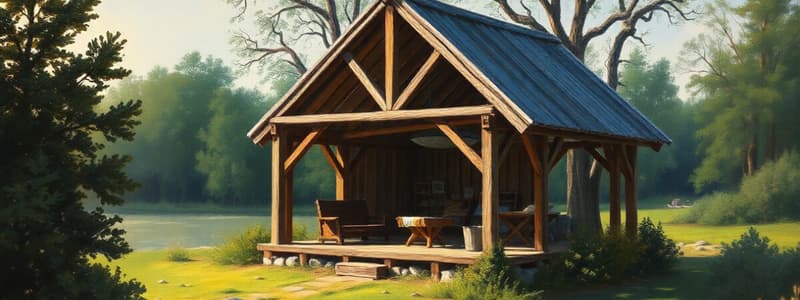Podcast
Questions and Answers
What is the recommended depth for covering the roof with boughs?
What is the recommended depth for covering the roof with boughs?
- 10 cm (4 inches)
- 25 cm (10 inches)
- 15 cm (6 inches) (correct)
- 20 cm (8 inches)
Which connection method involves using a pole placed in the forked part of another pole?
Which connection method involves using a pole placed in the forked part of another pole?
- Tie
- Crotch (correct)
- Crotch Pole
- Tripod
When adding a fabric covering in low temperatures, what is the correct order of application?
When adding a fabric covering in low temperatures, what is the correct order of application?
- Boughs and fabric simultaneously
- Boughs first, then fabric
- Fabric first, then boughs (correct)
- Neither fabric nor boughs are needed in low temperatures
What is the purpose of using light-colored fabric for the shelter?
What is the purpose of using light-colored fabric for the shelter?
Which connection method involves three supporting poles forming a base?
Which connection method involves three supporting poles forming a base?
What is a key feature of the lean-to shelter construction?
What is a key feature of the lean-to shelter construction?
What influences the type of shelter that should be constructed?
What influences the type of shelter that should be constructed?
What is the advised slope angle for the roof of a lean-to to effectively shed precipitation?
What is the advised slope angle for the roof of a lean-to to effectively shed precipitation?
How should the size of a lean-to be determined?
How should the size of a lean-to be determined?
Which of the following materials can be used to cover a lean-to?
Which of the following materials can be used to cover a lean-to?
What is the primary advantage of a lean-to shelter in winter conditions?
What is the primary advantage of a lean-to shelter in winter conditions?
Which arrangement is less comfortable for sleeping in a lean-to?
Which arrangement is less comfortable for sleeping in a lean-to?
When constructing two lean-tos facing each other, what is a common problem?
When constructing two lean-tos facing each other, what is a common problem?
What is the initial step in building a suspension tepee?
What is the initial step in building a suspension tepee?
What is the minimum height for the poles used in constructing a tripod for a suspension tepee?
What is the minimum height for the poles used in constructing a tripod for a suspension tepee?
What is the purpose of the extra gores of silk in the construction of the tent?
What is the purpose of the extra gores of silk in the construction of the tent?
What construction step should be taken before raising the tepee's canopy if a fire is planned?
What construction step should be taken before raising the tepee's canopy if a fire is planned?
Why might a smoke-filled tepee be beneficial in specific insect-repellent situations?
Why might a smoke-filled tepee be beneficial in specific insect-repellent situations?
What is a necessary feature of the vent hole in a smoke-filled tepee?
What is a necessary feature of the vent hole in a smoke-filled tepee?
What should be used to secure the desired size of the vent opening?
What should be used to secure the desired size of the vent opening?
Flashcards
Brush Lean-To Framework
Brush Lean-To Framework
The basic supporting structure of a brush lean-to, constructed from poles.
Covering the Framework
Covering the Framework
Using natural materials (boughs) to cover the framework to create a roof and sides, at least 15 cm deep.
Fabric Covering Alternative
Fabric Covering Alternative
Using parachute or wing covers as an alternative covering (or with boughs) for a brush lean-to.
Connecting Poles (Tie)
Connecting Poles (Tie)
Signup and view all the flashcards
Crotch Connecting
Crotch Connecting
Signup and view all the flashcards
Lean-to Shelter
Lean-to Shelter
Signup and view all the flashcards
Lean-to Materials
Lean-to Materials
Signup and view all the flashcards
Lean-to Size
Lean-to Size
Signup and view all the flashcards
Lean-to Slope Angle
Lean-to Slope Angle
Signup and view all the flashcards
Lean-to Construction
Lean-to Construction
Signup and view all the flashcards
Lean-to comfort
Lean-to comfort
Signup and view all the flashcards
Two lean-to sharing fire
Two lean-to sharing fire
Signup and view all the flashcards
Suspension tepee parts
Suspension tepee parts
Signup and view all the flashcards
Suspension tepee setup
Suspension tepee setup
Signup and view all the flashcards
Tepee Size & Inhabitants
Tepee Size & Inhabitants
Signup and view all the flashcards
Tepee Fire Vent
Tepee Fire Vent
Signup and view all the flashcards
Tepee Vent Placement
Tepee Vent Placement
Signup and view all the flashcards
Tepee Vent Design
Tepee Vent Design
Signup and view all the flashcards
Smoke Repellant
Smoke Repellant
Signup and view all the flashcards




